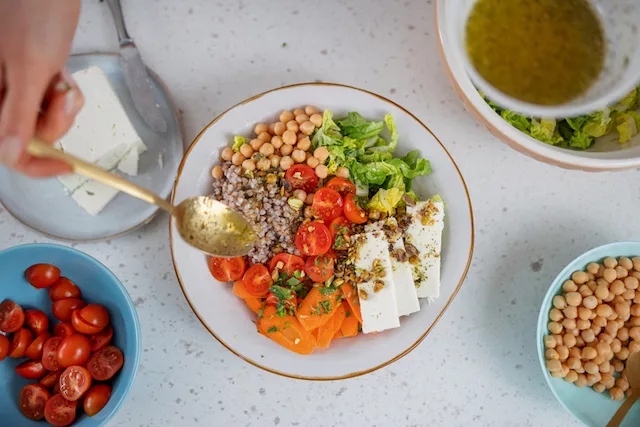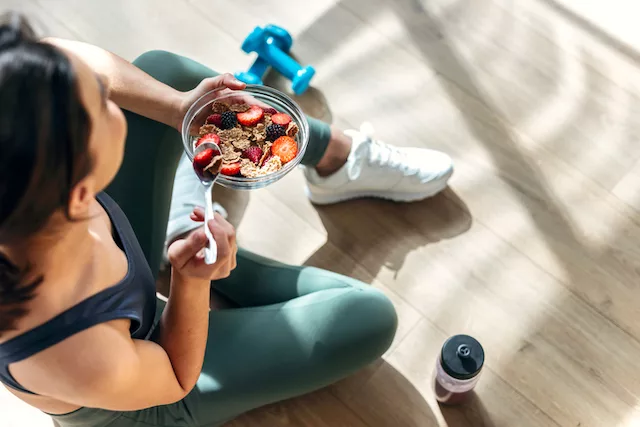When starting (GLP-1 RAs) medications like Wegovy, Ozempic, Zepbound, or Mounjaro, following a nutrition plan that supports your body’s needs is crucial. While these medications don’t require restricting certain macronutrients, what you eat still plays a vital role in how well the drug works for you. A balanced diet can help prevent unwanted side effects and ensure you get the most out of your medication. In this guide, we’ll cover how GLP-1 RAs medications work in the body, along with what foods to consume (and which to avoid) to get the best results from your medication.
How GLP-1 Medications Work
With these particular weight loss/T2D medications, active ingredients Semaglutide and tirzepatide mimic GLP-1 (Glucagon-like peptide-1), the naturally occurring hormone produced in the GI tract. When you eat, your body breaks down carbohydrates into simple sugars, which then enter the bloodstream. GLP-1 signals your pancreas to release insulin, which helps your cells absorb glucose for energy. This process also slows digestion, helping you feel fuller for longer, and regulates blood sugar levels. These effects make GLP-1 medications effective for weight loss and managing blood glucose levels in individuals.
Why Your Nutrition on GLP-1 Medication Matters
“While on a GLP-1 medication, you may experience changes in hunger and even experience food aversions,” says Brittany Werner, MS, RDN, director of coaching at Working Against Gravity. She continues, “However, it’s essential you’re still getting enough nutrients and total calories for proper body functions.” That means when it comes to your GLP-1 diet, every bite counts. Your food choices should be nutrient-dense, whole, and minimally processed. Poor nutrition habits can lead to a number of consequences, including hypoglycemia, cardiovascular issues, and loss of muscle mass. Choosing the right foods enhances the effects of the medication, managing healthy blood sugar levels and supporting overall health.


Foods to Eat (and Avoid) on GLP-1
A diet that supports GLP-1 medications should focus on a variety of whole foods rich in essential nutrients. Here’s a breakdown of some of the types of foods to include in your diet.
Fats
Healthy fats are vital for GLP-1 users as they help regulate blood sugar and keep you feeling full longer. Monounsaturated fats and omega-3 fatty acids, in particular, are encouraged as they can help increase GLP-1 production.
Fats to eat:
- Avocados
- Nuts (peanuts, almonds, pistachios, walnuts)
- Olive oil
- Chia seeds
- Flax seeds
Whole Grains
Whole grains, unlike their refined counterparts, are rich in fiber, which slows digestion and provides long-lasting energy. They also help manage blood sugar levels and prevent insulin spikes, which is crucial for those on GLP-1.


Whole grains to Eat:
- Oats
- Brown rice
- Pasta (whole grain)
- Quinoa
- Barley
- Millet
- Farro
Fiber
As you’ll find in most food groups, fiber plays a significant role in many ways. It helps aid digestion, slows the absorption of nutrients, and promotes a feeling of fullness, keeping you satisfied. High-fiber foods also help stimulate the release of GLP-1, which is beneficial for regulating appetite.
Fiber to Eat:
- Fruits and vegetables
- Legumes (beans, lentils, chickpeas)
- Whole grains
- Nuts and seeds
Carbohydrates
Carbohydrates are a great energy source for the body (especially when you are eating much less than usual), but it’s important to note the type of carb. Complex carbs are the best choice to keep you full while suppressing your appetite (thanks to the high levels of fiber). Avoid simple carbohydrates (breakfast cereals, soda or juice with high sugar, sweets) as much as possible. These can spike blood sugar and quickly digest, causing hunger and eventually overeating.
Carbohydrates to Eat:
- Oats
- Quinoa
- Starchy vegetables (sweet potatoes, corn, peas)
- Legumes (beans, lentils)
- Whole wheat products
Use portion control with carbohydrates and spread your intake throughout the day to manage blood sugar levels more effectively.
Fruits
While you can never go wrong with fruit due to its long list of nutrients, eating certain fruits on a GLP-1 diet is especially beneficial for supporting the medication. Grapes, berries, and pomegranates, for example, contain bioactive compounds such as polyphenols and flavonoids that can stimulate the body’s natural production of GLP-1. Many fruits also contain high fiber and antioxidants, which can improve insulin sensitivity.
Fruits to Eat:
- Grapes
- Berries (strawberries, blueberries, raspberries)
- Bananas
- Apples
- Pomegranates
- Avocados
- Oranges
Vegetables
Like fruits, vegetables are also fiber-rich and support a healthy digestive system. Many vegetables (especially those that are non-starchy) have a low glycemic index. Therefore, they don’t cause rapid increases in blood sugar and are ideal for those on a GLP-1 diet. Plus, you can fill your plate with veggies and stay within a calorie deficit.
Vegetables to Eat:
- Leafy greens (spinach, kale, Swiss chard)
- Broccoli
- Brussels sprouts
- Carrots
- Onions, garlic
- Asparagus
- Zucchini
Protein
Eating enough protein daily is an absolute necessity for those taking GLP-1 medication. While it provides satiety benefits, it helps preserve lean muscle mass, essential due to the weight loss and suppressed appetite that GLP-1 medications cause. Eating lean protein can also slow the absorption of carbohydrates and prevent spikes in blood sugar after meals.
Protein to Eat:
- Lean proteins (chicken, turkey, eggs, fish like salmon and tuna)
- Dairy (Greek yogurt, cottage cheese, low-fat cheese)
- Soy-based proteins (tofu, edamame)
- Protein supplements (bars and shakes—check for artificial ingredients and sugar first)
So, how much protein should I eat to maintain healthy muscle mass?
“For those who are active and looking to maintain or build lean mass, a general guideline is to consume 0.8-1.0g of protein per pound of body weight,” Werner explains. “If you are just starting your wellness journey and 0.8-1.0g/lb is far too much for your current diet, start aiming for at least 30g of protein at every meal and build up from there.”
Hydration
Staying hydrated is essential for digestion, weight loss, and overall bodily function. Dehydration can reduce GLP-1 levels, so it’s crucial that you stay well-hydrated. Also, try to avoid sugary drinks (e.g., sodas, energy drinks, juice), as these can cause spikes in your blood sugar and actually counteract the benefits of your medication.
Beverages to Drink:
- Water
- Tea
- Coffee (unsweetened)
Foods to Avoid
As important as it is to know which foods can benefit your GLP-1 medication, it’s just as important to know which foods and drinks to stay away from. Many of these products can cause a spike in blood sugar, which then can counteract the beneficial effects of the GLP-1 medication. For others, it can cause gastrointestinal distress. Greasy or spicy foods can trigger symptoms of nausea, heartburn, bloating, or even vomiting, so it’s best to minimize these types of foods. Over time, GLP-1 medications will naturally reduce your cravings for these foods, but it’s best to be aware of them from the start.
Foods to Avoid:
- Processed foods
- High-sugar foods and beverages
- Refined carbohydrates (white bread, crackers)
- Fried or greasy foods
- Spicy or acidic foods (which can cause digestive discomfort)
- Alcohol in excess
In addition to this list, Werner explains that other factors can hinder the effects of the GLP-1 medication. “In addition to the high-calorie foods, skipping meals or simply not eating enough can drastically affect the medication. Eating too few calories can disrupt your metabolism and the medication’s efficacy. Stress is another factor to remember, as stress impacts our blood sugar regulation. Alcohol consumption should also be considered, as alcohol affects how your body metabolizes GLP-1, reducing its effectiveness. It’s best to limit your alcohol intake while taking a GLP1 medication. Since alcohol can interfere with blood sugar regulation, it has the potential to counteract the medication’s ability to manage insulin levels.”
The Takeaway on GLP-1 Diet and Facts
While good nutrition may be the major supporter alongside your medication, this is a lifestyle that requires commitment. That means focusing on nutrition, fitness, and wellness as a whole. All of these factors have to come together to get the most successful results and maintain those results long-term. (What happens when you stop taking GLP-1?) Prioritizing your diet with enough nutrients will support satiety, help manage healthy blood sugar levels, and prevent any nutrition deficiencies or muscle loss from occurring. By choosing nutrient-dense foods and taking care of your body, you’ll lose weight and maintain your overall health in the long run.

